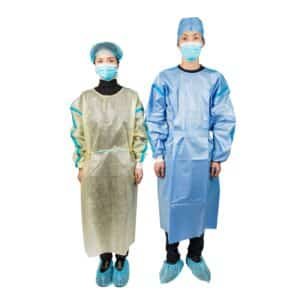Disposable gowns are a necessary part of any healthcare facility. They come in two main varieties: isolation gowns and surgical gowns. While both types of medical gowns have their unique benefits, it is important to understand the difference between medical gowns so you can make the best decision for your needs. In this blog post, we will discuss the key differences between disposable isolation gowns and disposable surgical gowns.
What are disposable gowns and what are they used for?
Disposable gowns are a type of clothing that is worn by healthcare workers in a hospital or other medical setting. They are made of a disposable material that can be easily cleaned and disposed of after use.
As healthcare workers, it is important to always use the appropriate personal protective equipment (PPE) when interacting with patients. This includes using disposable gowns when necessary.
There are two main types of disposable gowns: isolation gowns and surgical gowns.

Disposable protective gowns are used for a variety of purposes, including:
– Preventing the spread of infection
– Protecting people’s clothing from contamination
– Keeping people warm in cold environments
They are made of a disposable material that can be easily cleaned and disposed of after use.
The difference between isolation gowns and surgical gowns
Differences in materials
A isolation gown is typically made of a lightweight, breathable material that allows the people to stay comfortable. They are made of PP, PP+PE, or SMS materials.
The benefits of PP, PP+PE, and SMS materials include:
– PP is a lightweight and breathable material that allows the wearer to stay comfortable. It is also resistant to tears and rips.
– PP+PE is a strong and durable material that can provide better protection against contaminants. It is also resistant to tears and rips.
– SMS is a lightweight and breathable material that allows the wearer to stay comfortable.It is also resistant to tears and rips.It has good fluid intense procedures as the operating room gowns.

A surgical gown is usually made of a high quality non woven SMS fabric. This fabric is comfortable to wear and provides protection against contaminants. It is also resistant to tears and rips.They are used in emergency room as medical gowns.
The ultra fabric used in the reinforced impermeable long sleeves and chest area in the reinforced surgical gown.
The main difference between an isolation gown and a surgical gown is the level of protection they offer. Non surgical gowns are designed to protect the people from contact with potentially hazardous materials, while surgical gowns are designed to protect the patient from contact with blood and body fluids.It is a personal protective garment.
Difference in style
There are a few different types of disposable isolation gowns available on the market. Some of the most common types include:
– Sterile gowns: These ppe gowns are designed for use in a sterile environment and are typically made of a lightweight, breathable material.
– Non-sterile gowns: These ppe gowns are designed for use in non-sterile environments and are typically made of a heavier, more durable material.
– Patient gowns: These protective apparel are designed for use with patients and are typically made of a lightweight, breathable material.
– Lab coats: These coats are designed for use in a laboratory setting and are typically made of a heavyweight, durable material.

Difference in craft
The main difference between disposable isolation gown and disposable surgical gown is the craftsmanship involved in their manufacture.
Isolation gowns are typically made of a less durable material than surgical gown, because they do not need to be as tough in order to protect people from contamination.
Surgical gowns, on the other hand, are made of a thicker, more durable material that can arterial blood draw and body fluid. They are also typically reinforced at key points to ensure maximum protection for people.It is the standard medical unit level.

A level rated isolation gown is different than a surgical gown in that it must offer full back coverage and has a barrier performance of at least a Level 1.
This level of protection is important for ensuring that the wearer is protected from contact with hazardous materials.There are two types of processes used in the production of cover gown: ultrasound and seam sewing.
Differences in standards
The main difference between disposable isolation gowns and disposable surgical gowns is the certification that they have received. Isolation gowns are typically not as heavily certified as surgical gowns.
This is because they do not need to be as tough in order to protect people from contamination. Surgical gowns, on the other hand, are heavily certified and tested to ensure that they can withstand contact with blood and other body fluid resistant. It can do basic care and healthcare.
How to choose the right disposable gown for your needs
When choosing gowns, it is important to consider the following factors:
– The type of environment you will be working in
– The level of protection based you need
– The level of comfort you require

If you are working in a high-risk environment, such as a hospital or laboratory, it is important to choose a disposable surgical gown. This type of gown will provide maximum protection against contaminants and get minimal risk.
If you are working in a less hazardous environment, such as an office or school, a disposable isolation gown may be more appropriate. This type of isolation gown is less heavily certified than a surgical gown, but it will still protect people from contamination. It is also more comfortable and breathable than a surgical gown.
The benefits of using disposable gowns
Стандартные преимущества:
Protects the wearer from contamination
Keeps the workplace clean and safe
Reduces the risk of infection
Эмоциональные преимущества:
Provides peace of mind in high-risk environments
For many people, the use of disposable gowns provides peace of mind in high-risk environments. By wearing a disposable gown, workers can feel confident that they are standard isolation protected from coming into contact with potentially hazardous materials.

Makes it easier to comply with safety regulations
Disposable gowns make it easier for workers to comply with safety regulations by protecting them from coming into contact with potentially hazardous materials. This can help to prevent the spread of infection and keep everyone safe.
Additionally, disposable gowns can help to keep the workplace clean and free of contaminants, which can further reduce risk of infectious diseases,a class II medical device is a disposable gown that is worn to protect the wearer from contact with blood, body fluids, and other potentially infectious materials.
Medical professionals who work in high-risk environments, such as hospitals and laboratories, should always wear disposable surgical gowns to protect themselves from contact with blood and other body fluids. These gowns are heavily certified and tested to ensure that they can withstand contact with these materials.
Disposable gowns offer a number of benefits, including:
Protection against contaminants
Disposable gowns protect people from coming into contact with potentially hazardous materials. This can help to prevent the spread of infection and keep people safe from harm.
Comfort and breathability
Disposable gowns are typically made of a lightweight, breathable material that allows the wearer to stay comfortable in even the most challenging environments. This can be especially beneficial in areas where there is a high risk of contamination.
Долговечность
Disposable gowns are designed to withstand contact with blood and other body fluid resistant, making them ideal for use in hospital or laboratory settings. This durability can help to keep the workplace clean and safe by preventing liquids and debris from coming into contact with clothing and skin.
The potential risks associated with disposable gowns
The potential risks associated with disposable gowns include:
– Exposure to harmful contaminants
– Lack of protection against certain types of contaminants
– Improper fit or sizing

The potential risks associated with surgical isolation gowns include exposure to blood and other body fluid resistant, contact with environmental surfaces, intensive care unit and inhalation of particles. These risks can be minimized by following the manufacturer’s instructions for use and by taking appropriate precautions when handling and disposing of the isolation gowns.
How to properly care for disposable gowns
There are three main ways to properly care for surgical isolation gowns:
– following the manufacturer’s instructions for use,
– taking appropriate precautions when handling and disposing of the gowns, and
– using proper storage methods.
When taking appropriate precautions when handling and disposing of the gowns, it is important to:
– avoid contact with contaminated surfaces,
– wear gloves when handling isolation gowns,
– wash hands after removing gloves, and
– dispose of isolation gowns in a designated biohazard container.
Proper storage methods for surgical isolation gowns include:
– storing in a dry, cool place away from direct sunlight,
– storing in a breathable container, and
– using a dedicated storage area for gowns.
У вас есть вопросы или предложения? Пожалуйста, сообщите нам об этом в комментариях ниже!
Этот пост в блоге подготовлен командой YouFu Medical. We’re a disposable isolation gown manufacturer with over 10 years of experience. If you’re looking for high-quality, affordable isolation gowns, please check out our website or contact us today! Thanks for reading!











